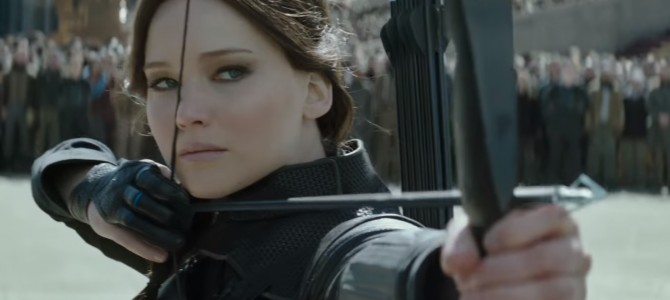
Warning: because this story all comes down to the end of the book and movie, it is virtually impossible to discuss without spoilers.
Is war ever worth fighting? According to Suzanne Collins’ The Hunger Games book trilogy, probably not, no matter how vicious the enemy or evil their tactics.
The second half of Collins’ last book comes to the big screen this week with a star-studded “The Hunger Games: Mockingjay Part 2,” but the film expands and in some ways reverses Collins’ anti-war conclusion for the better.
We find Katniss Everdeen (Jennifer Lawrence) fitfully recovering from yet another near-lethal experience. Her erstwhile boyfriend and teammate Peeta (Josh Hutcherson), under the influence of post-traumatic stress disorder and enemy indoctrination, wants to kill her. Her other erstwhile boyfriend, Gale (Liam Hemsworth), fights on the front lines. Katniss chafes at her role imposed by rebel leader Coin (Julianne Moore) to be a figurehead and popular symbol. She would rather battle to the door of her enemy President Snow (Donald Sutherland) and run him through with her trusty arrow.
So she does. The bulk of the movie shows Katniss’s advance on the Capitol, accompanied by a hearty band of friends, traitors, and fellow soldiers. The Capitol has booby-trapped the streets so the platoon is under threat from the same array of fantastic beasts and catastrophic forces that overwhelmed so many in the Hunger Games arena. This time, the games are real and on the streets.
Bleak, But Not Distasteful
The film is bleak, although perhaps not as bleak as prior versions, which showed children battling to the death for the entertainment of the masses. This film progresses along the lines of more conventional urban warfare, with the innocent at risk but not participants.
Like the previous three films, the movie is well done. Lawrence is fantastic from the very first scene. In scenes filmed before his death, Phillip Seymour Hoffman is so natural and wonderful, you miss him all over again. His absence is felt at the end, where a letter heroically tries but inadequately replaces the man.
The action comes quickly and tension ratchets up nicely, especially in underground scenes, all misty tunnels lit only by rifle lights but filled with menace. Rated PG-13, the movie has extremely minimal sexuality (clothed characters lying in bed talking and occasional kisses) and no bad language, but it is extremely violent and dark for a kids’ flick. The violence is not gory, but it is tense, emotional, and pervasive. Characters die, including characters to whom we have become attached. It is fine for teens, but may be too intense for younger viewers.
Reversing the Pacifist Book Message
The surprise for those who read and love the books comes at the end. Although the plot remains, for the most part, the same, the tone is so different as to reverse the pacifism-at-all-costs message of the book.
In the book, the ending comes as Katniss becomes more and more driven to seek vengeance against the Capitol in general and Snow in particular. She becomes disillusioned with the rebels, especially with their leader Coin, and comes to see all movements as players manipulating soldiers like pawns in a sick, repeating game.
In the book’s world, there are no good guys and nothing is worth fighting for. The best one can hope is to retire far, far away and live a private and solitary life.
I’ve talked to a lot of people who have read the books, and I hear a common theme. They hate the ending. They feel the rug has been yanked out from beneath them. Part of this is due to Collins’ skill. She paints such a picture of injustice and parasitic dictatorship that the only answer is to resist. She creates Katniss as a vision of pure-hearted sanity and her sister Primrose as a symbol of innocent goodness. Surely protecting such things justify fighting?
But then she takes it all away. Katniss is left as a shell, the movement for which she sacrificed so much only an illusion, the family she loves shattered, one man lost and the other wounded. The fact that Collins, writing post-9/11 and in the shadow of Vietnam, put Bush-era slogans in the mouth of Coin only heightens the effect. Coin claims to be fighting for freedom and democracy, but she is of the same cloth as the dictator Snow.
Somber Victory Replaces Nihilism
It’s no mistake. Collins is a pacifist of the most pacifistic kind, which she has revealed in interviews and her other works. In her Underland series, even blatant genocide doesn’t justify fighting. Human-like characters are marched to gas chambers, but fighting back is dubious.
After finishing “Mockingjay,” the book, my daughter told me she just wanted to sit in a room and bang her head against a wall. Without changing much about the plot of “Mockingjay” the movie, the wizards at Lionsgate managed to make the film much more hopeful and meaningful. One way they did so was incorporating a character, a single leader, in which one could believe. She plays a small role but becomes a complete counterpoint to the likes of Coin and Snow. Because of her, the war is not fought in vain, the deaths of so many were not meaningless. Katniss even finds something she is denied in the book: a measure of peace and happiness.
I do not usually like variations from the source material, and I walked into the film dreading the ending, but in this case I was pleasantly surprised. With the shift in tone, the story becomes a Harry Potter or “Lord of the Rings”-type tale of great desperation, great cost, and ultimate somber victory instead of a depressing journey into nihilism.









